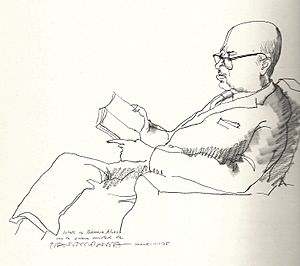Dámaso Alonso facts for kids
Quick facts for kids
The Most Excellent
Dámaso Alonso
|
|
|---|---|

Alonso portrait by Josep Pla-Narbona
|
|
| Born |
Dámaso Alonso y Fernández de las Redondas
22 October 1898 Madrid, Spain
|
| Died | 25 January 1990 (aged 91) Madrid, Spain
|
| Seat d of the Real Academia Española | |
| In office 25 January 1948 – 25 January 1990 |
|
| Preceded by | Miguel Asín Palacios |
| Succeeded by | Francisco Rodríguez Adrados |
| Director of the Real Academia Española | |
| In office 5 December 1968 – 26 November 1982 |
|
| Preceded by | Vicente García de Diego |
| Succeeded by | Pedro Laín Entralgo |
Dámaso Alonso y Fernández de las Redondas (born October 22, 1898 – died January 25, 1990) was an important Spanish poet, language expert, and book critic. He was part of a famous group of writers called the Generation of '27. However, his most well-known works were written later, starting in the 1940s.
Early Life and Studies
Dámaso Alonso was born in Madrid, Spain, on October 22, 1898. He studied different subjects like Law, Philosophy, and Literature. Later, he did special research at the Center for Historical Studies in Madrid.
He was very active in the cultural scene at the famous Residencia de estudiantes (Students' Residence). Many other famous artists and writers lived there, like Federico García Lorca, Luis Buñuel, and Salvador Dalí. Dámaso Alonso also wrote for popular literary magazines such as Revista de Occidente and Los Cuatro Vientos.
A Career in Academia
Dámaso Alonso became a very respected professor. He taught Spanish language and literature at several universities outside Spain, including the University of Oxford in England. From 1933 to 1939, he taught at the University of Valencia in Spain. After that, he moved to the University of Madrid.
In 1945, he was chosen to be a member of the Real Academia Española, which is like the official Spanish language academy. He even served as its director, or head, from 1968 to 1982. After that, he was named director emeritus, which means he held the title for life.
His Writing Journey
Dámaso Alonso's writing career can be seen in two main parts. His early poems, like Poemas puros (1921) and El viento y el verso (1925), are not considered as strong as the work of other poets from his group. He even called himself a "part-time poet."
However, his later work, especially Hijos de la ira (Children of Wrath), published in 1944, became very important for Spanish literature after the Spanish Civil War. This book showed a deeper, more serious side to his poetry.
As a literary critic, Dámaso Alonso had a big impact. He changed how people studied Spanish Baroque poetry, especially the works of Góngora. His critical writings were praised for being very smart and detailed. Some of his important critical books include Poesía de San Juan de la Cruz (1942) and Poesía española (1950).
Awards and Honors
In 1962, Dámaso Alonso was chosen to be a member of the American Philosophical Society. This is a group that honors important thinkers and scholars. In 1978, he received the Premio Cervantes. This is the highest award for literature in the Spanish-speaking world, like a Nobel Prize for Spanish writers.
See also
 In Spanish: Dámaso Alonso para niños
In Spanish: Dámaso Alonso para niños
- A lo divino

